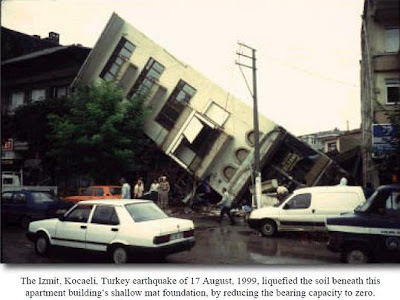Definition
The condition, in which the soil has little or no shearing strength and will flow as a liquid is known as liquefaction.
Mechanism of liquefaction
strength of saturated cohesionless soils depends upon the effective stress acting between particles. When external forces cause the pore volume of a cohesionless soil to reduce the amount V, pore water pressures are increased during the time required to drain a volume V of water from the soil element.
Consequently, pore pressure increases depend upon the time rate of change in pore volume and the drainage conditions (permeability and available drainage paths). When conditions permit the pore pressure, u, to build up to a value equal to the total stress, sn, on the failure plane, the shear strength is reduced to near zero and the mixture of soil grains and water behaves as a liquid.
Consequence of liquefaction
Liquefaction or flow failure of sands involves a substantial loss of shearing strength for a sufficient length of time that large deformations of soil masses occur by flow as a heavy liquid. Stucture sink into soil or suffer excessive settlement, resting on such soil without considering liquefaction.
Liquefaction due to seismic activity
Soil deposits that have a history of serious liquefaction problems during earthquakes include alluvial sand, aeolian sands and silts, beach sands, reclaimed land, and hydraulic fills. During initial field investigations, observations that suggest possible liquefaction problems in seismic areas include low penetration resistance; artesian heads or excess pore pressures; persistent inability to retain granular soils in sampling tubes; and any clean, fine, uniform sand below the groundwater table. The liquefaction potential of such soils for structures in seismic areas should be addressed unless they meet one of the criteria in Table below . In the event that none of the criteria is met and a more favorable site cannot be located, the material in question should be removed, remedial treatment applied , or a detailed study and analysis should be conducted to determine if liquefaction will occur.
Table - Criteria for Excluding Need for Detailed Liquefaction Analyses
1. CL, CH, SC, or GC soils.
2. GW or GP soils or materials consisting of cobbles, boulders, uniform rock fill, which have free-draining boundaries that are large enough to preclude the development of excess pore pressures.
3. SP, SW, or SM soils which have average relative density equal to or greater than 85 percent, provided that the minimum relative density is not less than 80 percent.
4. ML or SM soils in which the dry density is equal to or greater than 95 percent of the modified Proctor (CE 55) density.
5. Soils of pre-Holocene age, with natural overconsolidation ratio equal to or greater than 16 and with relative density greater than 70 percent.
6. Soils located above the highest potential groundwater table.
7. Sands in which the "N" value is greater than three times the depth in feet, or greater than 75; provided that 75
percent of the values meet this criterion, that the minimum "N" value is not less than one times the depth in feet, that there are no consistent patterns of low values in definable zones or layers, and that the maximum particle size is not greater than 1 in. Large gravel particles may affect "N" values so that the results of the SPT are not reliable.
8. Soils in which the shear wave velocity is equal to or greater than 2000 fps. Geophysical survey data and site geology should be reviewed in detail to verify that the possibility of included zones of low velocity is precluded.
9. Soils that, in undrained cyclic triaxial tests, under isotropically consolidated, stress-controlled conditions, and with cyclic stress ratios equal to or greater than 0.45, reach 50 cycles or more with peak-to-peak cyclic strains not greater than 5 percent; provided that methods of specimen preparation and testing conform to specified guidelines.


No comments:
Post a Comment